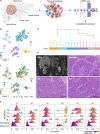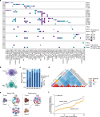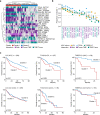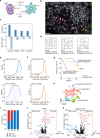Multiregional single-cell dissection of tumor and immune cells reveals stable lock-and-key features in liver cancer
- PMID: 36476645
- PMCID: PMC9729309
- DOI: 10.1038/s41467-022-35291-5
Multiregional single-cell dissection of tumor and immune cells reveals stable lock-and-key features in liver cancer
Abstract
Intratumor heterogeneity may result from the evolution of tumor cells and their continuous interactions with the tumor microenvironment which collectively drives tumorigenesis. However, an appearance of cellular and molecular heterogeneity creates a challenge to define molecular features linked to tumor malignancy. Here we perform multiregional single-cell RNA sequencing (scRNA-seq) analysis of seven liver cancer patients (four hepatocellular carcinoma, HCC and three intrahepatic cholangiocarcinoma, iCCA). We identify cellular dynamics of malignant cells and their communication networks with tumor-associated immune cells, which are validated using additional scRNA-seq data of 25 HCC and 12 iCCA patients as a stable fingerprint embedded in a malignant ecosystem representing features of tumor aggressiveness. We further validate the top ligand-receptor interaction pairs (i.e., LGALS9-SLC1A5 and SPP1-PTGER4 between tumor cells and macrophages) associated with unique transcriptome in additional 542 HCC patients. Our study unveils stable molecular networks of malignant ecosystems, which may open a path for therapeutic exploration.
© 2022. This is a U.S. Government work and not under copyright protection in the US; foreign copyright protection may apply.
Conflict of interest statement
The authors declare no competing interests.
Figures







Similar articles
-
Identification of molecular pattern and prognostic risk model based on ligand-receptor pairs in liver cancer.Front Immunol. 2023 Sep 25;14:1187108. doi: 10.3389/fimmu.2023.1187108. eCollection 2023. Front Immunol. 2023. PMID: 37818360 Free PMC article.
-
Onco-fetal Reprogramming of Endothelial Cells Drives Immunosuppressive Macrophages in Hepatocellular Carcinoma.Cell. 2020 Oct 15;183(2):377-394.e21. doi: 10.1016/j.cell.2020.08.040. Epub 2020 Sep 24. Cell. 2020. PMID: 32976798
-
Single-cell atlas of tumor cell evolution in response to therapy in hepatocellular carcinoma and intrahepatic cholangiocarcinoma.J Hepatol. 2021 Dec;75(6):1397-1408. doi: 10.1016/j.jhep.2021.06.028. Epub 2021 Jun 30. J Hepatol. 2021. PMID: 34216724 Free PMC article.
-
Single-Cell Transcriptomics of Liver Cancer: Hype or Insights?Cell Mol Gastroenterol Hepatol. 2022;14(3):513-525. doi: 10.1016/j.jcmgh.2022.04.014. Epub 2022 May 14. Cell Mol Gastroenterol Hepatol. 2022. PMID: 35577269 Free PMC article. Review.
-
Single-cell RNA sequencing reveals the landscape of the cellular ecosystem of primary hepatocellular carcinoma.Cancer Cell Int. 2024 Nov 14;24(1):379. doi: 10.1186/s12935-024-03574-0. Cancer Cell Int. 2024. PMID: 39543644 Free PMC article. Review.
Cited by
-
Characterization of T cell proliferation-associated hepatocellular carcinoma subtypes, predictive signatures, and candidate targets.J Gastrointest Oncol. 2025 Jun 30;16(3):1127-1143. doi: 10.21037/jgo-2025-50. Epub 2025 Jun 27. J Gastrointest Oncol. 2025. PMID: 40672093 Free PMC article.
-
Analysis of the implication of steroid 5 alpha-reductase 3 on prognosis and immune microenvironment in Liver Hepatocellular Carcinoma.Ann Med. 2024 Dec;56(1):2408463. doi: 10.1080/07853890.2024.2408463. Epub 2024 Sep 28. Ann Med. 2024. PMID: 39340288 Free PMC article.
-
Gene expression networks involved in multiple cellular programs coexist in individual hepatocellular cancer cells.Heliyon. 2023 Jul 17;9(7):e18305. doi: 10.1016/j.heliyon.2023.e18305. eCollection 2023 Jul. Heliyon. 2023. PMID: 37539322 Free PMC article.
-
Liver cancer from the perspective of single-cell sequencing: a review combined with bibliometric analysis.J Cancer Res Clin Oncol. 2024 Jun 24;150(6):316. doi: 10.1007/s00432-024-05855-7. J Cancer Res Clin Oncol. 2024. PMID: 38910204 Free PMC article. Review.
-
Integrated analyses reveal the prognostic, immunological features and mechanisms of cuproptosis critical mediator gene FDX1 in KIRC.Genes Immun. 2023 Aug;24(4):171-182. doi: 10.1038/s41435-023-00211-0. Epub 2023 Jul 10. Genes Immun. 2023. PMID: 37430022
References
-
- Black, J. R. M. & McGranahan, N. Genetic and non-genetic clonal diversity in cancer evolution. Nat. Rev. Cancer10.1038/s41568-021-00336-2 (2021). - PubMed
Publication types
MeSH terms
Substances
Grants and funding
LinkOut - more resources
Full Text Sources
Medical
Molecular Biology Databases
Research Materials
Miscellaneous

